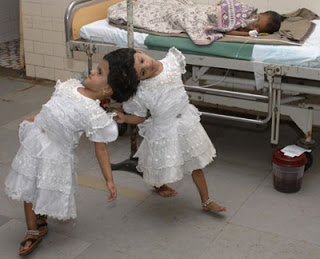FACTS ABOUT CONJOINED TWINS

 HOW ARE CONJOINED TWINS FORMED?
HOW ARE CONJOINED TWINS FORMED?Conjoined twins form when one sperm fertilizes
one egg, but at some point during the stage where the single egg splits, the
process stops, and the twins develop attached to one another. Identical twins
will only be conjoined if they separate after the 12th day of conception. The
twins will share a chorion, amnion and a placenta, making them
monoamniotic/monochorionic and subject to TTTS (Twin to Twin Transfusion Syndrome) and cord
entanglement (two reasons why many are miscarried). No one knows why conjoined
twins occur, although genetic and environmental factors have been explored.
Conjoined twins are always of the same sex. Some
types (dicephalus and ischiopagus for example) may only have one set of
external genitalia (or none at all), leading many misinformed news people to
refer to boy/girl conjoined twins or cases where one is a boy or girl and the
other is unknown (in fact, the other twin will always be the same sex as the
co-twin). DNA testing has to be done to determine the sex of conjoined twins
who have no external genitalia. In some cases, after separation, the twin
without the external genitalia has been turned into a member of the opposite
sex (seen in at least 2 cases).
STATISTICS
Conjoined twins occur in approximately 1 in
every 40,000 births, but only once in every 100,000 to 200,000 live births.
60% of conjoined twins are either stillborn or
lost in utero, and 35% of twins that survive birth die within the first 24
hours (mostly because the most common locations of conjoinment involve
important systems such as the heart). Out of 100 conceptions of conjoined
twins, only 26 sets will survive birth and the first 24 hours.
Conjoined twins are most likely to be female –
71.62% are girls, while 28.38% are boys. This is because male twins are more
likely to be miscarried (as are all male babies).
They are most likely to occur in India or Africa than in China or the US. (Although the rates in Vietnam have been much higher in recent years, possibly due
to Agent Orange exposure).
The birth rate of conjoined
twins in Africa is approximately 1 in every 14,000 births. One in every 400 identical twin pregnancies will
be conjoined twins.
TYPES OF CONJOINED TWINS
half of the body with two faces on opposite sides of a conjoined head. Joined
by the face, containing a single head and two bodies. The head has a single
face with four ears, two on the back of the head. This type is extremely rare
and non-viable. Also called Syncephalus, Janiceps or Janus twins.
There is only one brain and head (sometimes a rudimentary 2nd face), and they
usually share a heart and have fused gastrointestinal tracts. They are
non-viable. They are similar to Cephalopagus, but with fusion of the chest as
well as the head, and are slightly more common than true cephalopagus twins.
Also called Cephalothoracopagus Syncephalus, Epholothoracopagus or
Craniothoracopagus.
upper thorax down to the umbilicus, with heart involvement, 90% have a shared
heart and 75% have extensively conjoined hearts that can’t be surgically
separated. Four arms, four legs, two pelvises. Accounts for about 35% of
conjoined twins.
in the area of the umbilicus, and sometimes involving the lower thorax, but
always preserving two distinct hearts. There is not even a cardiac vessel in
common. Conjoined livers are very common. Two pelvis, four arms and four legs.
Accounts for about 30% of conjoined twins.
and omphalopagus, these twins will be attached from the upper chest to the
umbilicus, and will usually share a heart. About 90% of thoraco-omphalopagus
twins have a common pericardium and 75% have conjoined hearts. Also may have
shared livers and gastrointestinal tracts. Four arms and four legs are present.
Xipho-omphalopagus twins may look more like thoraco-omphalopagus but will not
have heart involvement.
(the smallest of the three divisions of the sternum, below the gladiolus and
manubrium). They are joined roughly from the navel to the lower breastbone.
These twins rarely share vital organs aside from the liver. This is a subset of
omphalopagus.
a large conjoined pelvis with two sacrum and two symphyses pubis. They are
joined end-to-end with the spine in a straight line. Four arms, a variable
number of legs, and in general, a single external genitalia and a single anus,
but sometimes genitalia and located internally. Accounts for about 6% of all
conjoined twins.
and ischiopagus, these twins present joined as ischiopagus twins are, but
face-to-face with a joined abdomen. Four arms, and a variable number of legs
are present. The main indication here is a fusion of the pelvis, which you
won’t see in thoraco/omphalo/xipho-pagus twins. There has also been cases of
thoraco-omphalo-ischiopagus and xipho-omphalo-ischiopagus twins where the union
extends upwards to the chest.
pelvis, one symphysis pubis and one or two sacrums, united side by side. This
type account for about 5% of all conjoined twins. It is possible for them to
share a heart (if one has situs inversus of the heart), but rare. They may
share the liver, kidneys and other organs.
the abdomen and pelvis (does not involve the thorax). This is a subset of
parapagus twins. They will be of the dipus type. They will likely have their
own hearts, although some will have situs inversus (reversed organs) and could
possibly share a heart as well.
abdomen, pelvis and thorax. Dicephalus have one trunk with two heads. They are
always of the dipus (two leg) type, and 3rd and 4th arms may present on their
backs. This is a subset of parapagus twins. They may share a heart and other
organs. The rarest type of parapagus twins is dicephalus dipus dibrachius.
head with two faces. Various degress of duplication of the face and brain can
be seen. This is the most uncommon and rare type of conjoined twinning. Also
called Monocephalic Diprosopos.
skull, except the face or foramen magnum (base of the skull). They share bones
of the cranium, meninges, and occasionally brain surface. Two trunks, four arms
and four legs. Accounts for about 2% of all conjoined twins. The twins can be
joined end to end (vertical), at the back of the head (occipital), front of the
head (frontal), side of the head (parietal/temporal).
PYGOPAGUS
sacrococcygeal, perineal regions and occasionally the spinal cord. There is one
anus, two rectums, four arms and four legs. Accounts for about 19% of all
conjoined twins.
the sacrum and lumbar spine, involving different segments of the column. This
type is extremely rare, with only one recorded set born in 1960, joined
mid-spine to the top of the head with fused skills. There have been 20 cases of
rachipagus parasitic twinning.
SEPARATION
The majority of separated twins will have some
kind of disability, whether it be physical or mental. Omphalopagus and
xiphopagus twins are most likely to have good health after separation. Many
ischiopagus twins will have a physical disability due to the fact they often
have only 2 or 3 legs between them. Craniopagus separated twins are most likely
to suffer mental disabilities.
- EVERYDAY MAKEUP ROUTINE FOR A FRESH AND NATURAL LOOK - April 6, 2024
- MIXING AND MATCHING PATTERNS LIKE A PRO - February 23, 2024
- 10 WARDROBE ESSENTIALS EVERY FASHIONISTA SHOULD OWN - February 11, 2024






